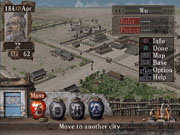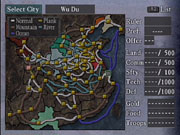In this age of flashy 3D graphics, superficial whiz-bang features, and a generally overwhelming amount of fluff in video games, it's good to know that some companies aren't afraid of sticking to their roots. That's exactly what Koei has done with Romance of the Three Kingdoms VII, its newest entry in the venerable strategy series. The game harkens to a faraway time when graphics were secondary to complex and involving gameplay, but its adherence to those old ways will ultimately limit its appeal to a selective audience.

Longtime console strategy gamers are without a doubt the group Romance of the Three Kingdoms VII is squarely targeted at, and for them, the series needs no introduction. Newcomers may not be familiar with the basis of the series, however, which is deeply embedded in actual Chinese historical events. Like its predecessors, Romance VII takes place directly after the final collapse of the Han Dynasty in the second century AD. A great number of warring states and ambitious rulers vied for land and dominance during this period, and the conflict provides the impetus behind the gameplay in the video game version. In short, your ultimate goal is to bring all the factions together under your banner.
How you go about uniting China, and even what role you play in this unification, is up to you. There are five basic character classes available in Romance VII: ronin, common officer, warlord, prefect, and liege. All five are based on the same gameplay interface, which is strictly a textual menu-driven affair that gives you access to various character commands that let you control everything from your monetary income to your character's area of study and his correspondence with other officers. Though the interface remains identical, each class has access to its own unique commands and abilities. For instance, the ronin--a warrior without a master--is free to move back and forth between cities, meeting new people and observing the state of the country at large. A prefect, on the other hand, is a city overseer and is therefore more or less bound to the city he's been assigned to, governing its affairs. You can choose to start out in any of the five positions, and you can actually ascend through the ranks. Do enough good deeds as a ronin in a particular city, for example, and you may be asked to join the city as a common officer. Through hard work and diligence, you may eventually become a liege yourself and go on to bring the people of China together.
Indeed, hard work and diligence are the names of the game in Romance of the Three Kingdoms VII, and for hard-core strategy buffs, this is definitely the game's saving grace. Less committed gamers, or those looking for a more action-packed experience, will find this aspect to be damning, however. Like the previous games in the series, Romance VII is driven entirely by numerical statistics, menu selections, and the meticulous delegation of your troops, resources, and diplomatic prowess. You won't conquer China by grabbing a spear and single-handedly assaulting the enemy hordes on lush 3D battlefields, as you do in another of Koei's franchises, Dynasty Warriors. In fact, there's nary a polygon to be found in all of Romance VII. Even the battles are calculated, plodding, turn-based affairs that hinge far more on your ability to strategize than your ability to mash buttons. The game's graphics don't take serious advantage of the PlayStation 2's hardware, although all the art and menus are at least in high resolution. The point of Romance VII isn't graphics, though, but rather a limitless amount of involving strategy gameplay.

"Limitless" may actually be an inaccurate way to describe replay value, but Romance of the Three Kingdoms VII comes as close to that impossibility as any game has. It features so many historically accurate characters and locations that it would take months of playing to go through them all. Initially, you can choose from 10 different scenarios to play through, and at the beginning of each you can choose one of the five classes. Once done, you can pick your character from a truly massive list of historical personalities or simply create your own. In terms of innovation, none of this adds up to much--Koei has simply thrown more fuel on the fire of past titles. For serious strategy fans, though, this is surely the best entry yet in the series.
There are a number of things required to fully enjoy Romance of the Three Kingdoms VII. For one, you'll need the patience and interest to pour hours upon hours into the game, tirelessly tracking all your statistics as you slowly progress through the military and political ranks. A lack of concern for flashy graphics is also a must. Finally, an interest in Chinese history and culture is a plus, especially since you'll be under pressure to keep up with the onslaught of Chinese names. Likewise, there's a list of things that will prevent your enjoyment of Romance VII--a desire for action and a need for newness and innovation number among them. Romance of the Three Kingdoms VII is a good game, but it's not for everyone.